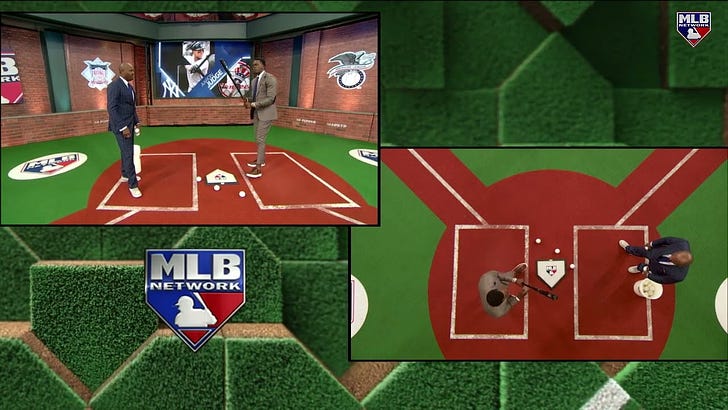Aaron Judge is killing baseballs. 46 homers. Second place is 34. Top of average exit velocity, third in peak behind Giancarlo Stanton and Shohei Ohtani, so that tracks. The “on pace for” meter is set and with 46 games to go, we may get to go places we haven’t been since the magical fall of 1998, or Barry Bonds’ run to 73 and 762.
Look, I get it. In retrospect and even at the time, there were issues that we didn’t have the full context for. I’m not in the mainstream on my views regarding these, but why is 61 or 755 still magical, but 73 isn’t? Does anyone attach importance to 892, or 16,726? (Those are Gretzky’s goals and Payton’s career yardage, btw.)
What Judge is doing is astounding. No doubt about it. Judge showed up in the league bigger, stronger, much in the way that Albert Pujols did as a rookie. The name on his jersey stretched across a back that seemed too big to be a baseball player. I can remember seeing Pujols, Matt Holliday, and Mark McGwire standing at an indoor cage and then seeing David Eckstein walk past. That’s the extreme, but we’ve all seen the picture of Judge and Jose Altuve. Somehow, Judge doing big things isn’t surprising, but I’m not sure we get the full context of how much outside the scope Judge is in one area.
For the rest of baseball, they seem to have the dead ball. Judge, it doesn’t matter. I was recently reading a study on the change in golf balls and how it’s affected the game over the last decade. I don’t pretend to know much about golf, but the ability to track things like distance, spin, and trajectory is identical to what we’ve learned in baseball merely by being able to track them. Thanks, Trackman! In this study, the idea was that specifically designed balls were a major advantage - more spin, more touch, more distance, depending on player and course - and it seems somehow that Rawlings has done that for Judge.
Of course, if you’ve read Chapter 1 of The Science of Baseball, my theory is that Rawlings not only isn’t selecting, but is basically incompetent, changing the ball without knowing how to get to the “Goldilocks ball” that Rob Manfred seems to think they can make. As majority owner of Rawlings, MLB should, but they haven’t demonstrated that.
Instead, I think that what Rawlings has put out has, in concert with league wide humidors and enforced usage, created a ball that acts in a specific way. When hit really hard, the ball goes farther, but less so at lower exit velocities. That could be a function of drag or deformity, but I’ll leave that to Dr. Meredith Wills to explain and test. I asked her if my theory was plausible and she said this:
“Assuming MLB is using a single baseball this season, balls with comparable exit velocities should suffer from comparable levels of deformation, and hence have comparable changes in drag. I suspect a ball that’s hit harder would be more deformed and end up with higher drag. However, published drag data—such as that now available from Statcast—is usually derived from pitched balls, not batted ones. Without knowing how impact affects carry, I’m not sure we can draw conclusions.”
Not drawing those conclusions is tougher these days. If everyone in the 90’s and 2000’s carried the steroid doubt, I’m not sure how we get away from the baseball shenanigans of the past few seasons. Judge’s feat can’t simply be compared to other players, of this year or any other, if we can’t trust the very basics. As Judge steadily raises his total, the questions are bound to get louder. For now, let’s get to the injuries:
CLAY HOLMES, RP NYY (back spasms)
A scout earlier this season asked me a question that’s hung with me all season. “What didn’t the Pirates see in Clay Holmes?” I don’t think it’s so much that the Pirates didn’t see talent, but it was that the role - Yankees closer - is so much more visible than anything in Pittsburgh. Holmes was good and in moving to New York, his rate stats have stayed almost the same, with an improvement in control and command. What happened was that he was forced into the role with Aroldis Chapman’s struggles and injuries and succeeded as an unknown. The Pirates got two major league players back for a reliever, so I think this was just circumstance. Give a good player a chance and sometimes, things like this happen, though Holmes himself disagrees:
However, Holmes has been used heavily and maybe more important, stressfully. He’s been in almost all high leverage situations made more so by the pinstripes. The back spasms can’t be directly tied to usage, but they tend to happen when things get out of whack. The Yankees will use the IL time to work on the symptoms, but I’m most curious how they’ll use their data factory to help. They’ll know how his biomechanics have changed over the course of the season, which could lead to the root cause, often the toughest to find. I think they’re closer already, given the Yankees specified “left lower back”, which isn’t normally detailed.
Aroldis Chapman drops back in to his old closer role, given that he used his IL time to find himself again and while his velocity isn’t all back, he’s using his stuff to get people out, upping his strikeout rate since his return. I’m curious if Holmes will have a similar renaissance which will make Aaron Boone’s options interesting as the team gets to the playoffs. My guess is Boone’s lifelong connection to the game will make him more of a traditionalist and give it to the more senior player.




